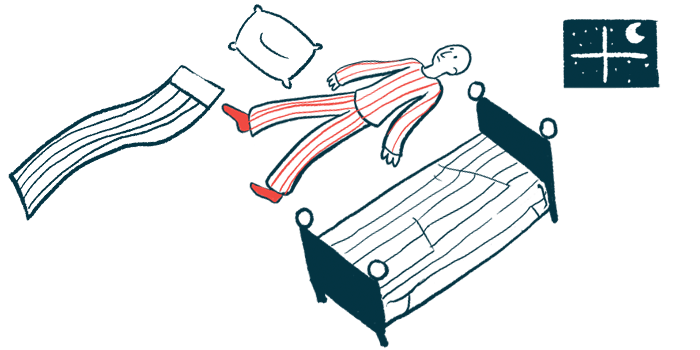Impaired sleep common among NMOSD patients, study finds
Poor sleep quality seen vs. healthy people; linked to worse disability

Most people with neuromyelitis optica spectrum disorder (NMOSD) have impaired sleep quality and architecture — an individual’s cyclical sleep pattern, involving different stages — relative to healthy people, according to a new study from researchers in India.
NMOSD patients were also found to have reductions in the volume of the thalamus, a brain region involved in regulating sleep-wake cycles.
In addition, increased disability was significantly associated with poor sleep quality, the researchers reported, noting that this further supports sleep patterns as an important parameter to be evaluated in NMOSD patients and targeted with care plans.
“Our patients with … NMOSD had [a] higher frequency of poor sleepers [and] excessive daytime hypersomnolence,” also known as severe daytime sleepiness, the researchers wrote.
Given these findings, further research is needed to better understand sleep patterns in NMOSD, and to determine “implications [for] comprehensive care,” the team wrote.
The study, “Study of sleep abnormalities in patients with NMOSD-MOG related disorders,” was published in Multiple Sclerosis and Related Disorders.
NMOSD is a rare condition in which the immune system mistakenly attacks healthy parts of the nervous system. This leads mostly to inflammation in the spinal cord and optic nerve (which sends signals between the eyes and the brain) and related symptoms.
In most cases, these inflammatory attacks are driven by self-reactive antibodies against the aquaporin-4 (AQP4) protein. Given that AQP4 is found in brain regions involved in sleep, disease attacks may negatively influence sleep in people with NMOSD. Moreover, there’s a close relationship between sleep and immune activity.
However, the researchers noted, few studies have closely investigated how sleep is impacted in NMOSD. Those that have done so have found that sleep problems are prevalent among patients. Sleep studies are also lacking for myelin oligodendrocyte glycoprotein associated disorders, or MOGAD, a disease that clinically overlaps with NMOSD but is driven by different self-reactive antibodies.
Impaired sleep found for nearly three-quarters of NMOSD patients
Now, a team of scientists from the National Institute of Mental Health and Neurosciences sought to learn more about sleep quality parameters. To that end, the team administered sleep questionnaires to more than 70 people with NMOSD and MOGAD. Among them, 27 NMOSD patients were positive for anti-AQP4 antibodies (AQP4-NMOSD), while 25 were not; those without such antibodies were called seronegative NMOSD (SN-NMOSD). Another 20 questionnaires were given to MOGAD patients.
People with AQP4-NMOSD had significantly more severe pain, anxiety, and depression than those with MOGAD. Most aspects of sleep were also more substantially impacted among those with NMOSD, the results showed.
Nearly three-quarters of people with NMOSD, regardless of their antibody status, were found to have impaired sleep quality, as assessed with the validated Pittsburgh Sleep Quality Index.
Many NMOSD patients also showed sleep-related issues, including excessive daytime sleepiness (22%-28%) and restless leg syndrome (30%-32%), a condition in which people experience an uncomfortable sensation in the legs while resting.
Also, 24% of people with SN-NMOSD and 15% of those with AQP4-NMOSD were at a high risk for obstructive sleep apnea, where breathing is repeatedly interrupted during sleep due to an airway obstruction.
One person with each type of NMOSD was considered to have probable REM-sleep behavior disorder, where a person acts out their dreams during the REM stage of sleep.
Researchers say disability, psychological aspects should be addressed
Altogether, 10 clinically stable people from each group, along with 20 healthy people, underwent a sleep study, known as a polysomnography, where brain waves and other physiological parameters are measured while a person sleeps.
Various alterations in sleep architecture were observed in people with NMOSD, the data showed. For example, these patients spent significantly more time than healthy people in stage 1 sleep — the lightest stage of sleep a person enters right after they’ve transitioned from wakefulness — and tended to spend less time in stage 3 sleep, the deepest part of the sleep cycle.
They also spent significantly less time in REM, an important period of sleep characterized by increased brain activity that’s important for memory consolidation and other brain functions.
There is an increased prevalence of poor sleep quality with reduced [stage 3 sleep] … [in people with NMOSD]. … This raises the importance of sleep patterns and should be included when delineating a comprehensive care plan for patients.
Across the study group, higher disability scores were significantly correlated with worse sleep quality, more severe anxiety and depression, restless leg syndrome, and a reduced time spent in stage 3 sleep. Certain types of brain or spinal cord lesions on MRI scans also correlated with various sleep parameters, according to the researchers.
Given these relationships, “addressing disability and psychological aspects may improve the sleep quality” of these patients, the team wrote.
Further analyses of MRI scans showed that people with NMOSD exhibited reductions in gray matter, the tissue in the brain and spinal cord that’s comprised of nerve cell bodies, especially in a region called the thalamus. As the thalamus plays an important role in regulating sleep cycles, this could in part explain some sleep disturbances, the scientists noted.
“There is an increased prevalence of poor sleep quality with reduced [stage 3 sleep] and thalamic volume” in people with NMOSD, the researchers wrote. “This raises the importance of sleep patterns and should be included when delineating a comprehensive care plan for patients.”
The team noted that larger studies, along with additional molecular and imaging analyses, are still needed to further understand how sleep is affected in NMOSD.








